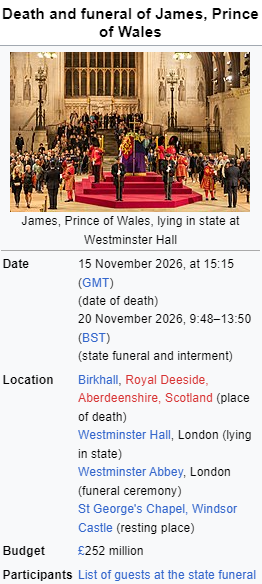HOME | DD
 AlbertW25 — Death and Funeral of Alexander I of Greece
AlbertW25 — Death and Funeral of Alexander I of Greece

#alternatehistory #alternateuniverse #wikibox
Published: 2024-01-24 21:08:00 +0000 UTC; Views: 731; Favourites: 1; Downloads: 0
Redirect to original
Description
On the 25th of October, 1984, Alexander I, the former King of Greece, the man who brought Greece to the territorial heights it had experienced, the man restored Constantinople to the Greek Throne, died at the age of ninety-one. He had ruled Greece from 1917 to 1946, having abdicated that year in favor of his brother, Paul I. He ended up outliving his brother, who died in 1966. His great-nephew, King Alexander II, would bring Cyprus to the Greek Kingdom in 1974. Throughout the time of his abdication to death, Alexander I was often busy trying to help the Kingdom and shore up the dynasty.Upon his death, many across Greece mourned the death of the man that had restored Constantinople back to the Empire and avenged the Fall of 1453. The funeral in Athens was attended by over eight million, with around sixty heads of state attending the service. After a period of mourning, the casket was taken by the Greek Cruiser Georgios Averof, from the Port of Piraeus all the way to Constantinople. There, the casket was taken to the replica Hagia Sophia. During his reign, Alexander I made an agreement with Mustafa Kemal Atatürk that would allow the construction of a replica of the Hagia Sophia, which the Turkish would be allowed to keep the original.
In the presence of the members of the Greek and Danish Royal Families, and with several film crews, the coffin was carefully and gently lowered into a specially built crypt in the center of the cathedral, with Demetrios I, Ecumenical Patriarch of Constantinople, blessing the tomb. The tomb was soon sealed with a slab that had the description 'Alexander The Great Unifier'.
When the tomb was sealed, the bellows of several great ox's were heard, the skies suddenly were covered in clouds, and the wind bellowed in that could be described as a mournful tone. Many interpreted this as a sign that the Legend of the Marble Emperor had been fulfilled. In fact, witnesses would later report that they had seen two figures on horseback on the hills outside of Constantinople. Many believed the figures to be those of Constantine the Great and Constantine XI, looking over the city that now bore their names.






















